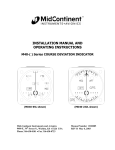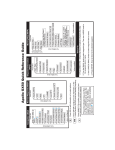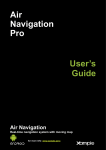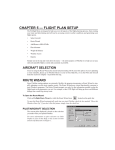Download Garmin GNC 300 GPS Receiver User Manual
Transcript
GARMIN International, Inc. 9875 Widmer Road Lenexa, KS 66215 U.S.A. FAA APPROVED AIRPLANE FLIGHT MANUAL SUPPLEMENT GARMIN GNC300 VHF COMMUNICATION TRANSCEIVER / GPS RECEIVER Table of Contents SECTION PAGE GENERAL..............................................................................................................4 LIMITATIONS ......................................................................................................5 EMERGENCY PROCEDURES.............................................................................6 NORMAL PROCEDURES ....................................................................................8 PERFORMANCE...................................................................................................16 WEIGHT AND BALANCE ...................................................................................16 AIRPLANE & SYSTEM DESCRIPTIONS ...........................................................16 FAA APPROVED DATE: 10/16/95 190-00067-03 Rev. A Page 3 of 16 GARMIN International, Inc. 9875 Widmer Road Lenexa, KS 66215 U.S.A. FAA APPROVED AIRPLANE FLIGHT MANUAL SUPPLEMENT GARMIN GNC300 VHF COMMUNICATION TRANSCEIVER / GPS RECEIVER SECTION I GENERAL 1. The GNC300 System is a fully integrated, panel mounted instrument, which contains a 760 channel VHF Communications Transceiver and a Global Positioning System (GPS) Navigation computer. The system consists of a GPS antenna, a GPS Receiver, and a VHF Communications Transceiver. The primary function of the VHF Communication portion of the equipment is to facilitate communication with Air Traffic Control. The primary function of the GPS portion of the system is to acquire signals from the GPS system satellites, recover orbital data, make range and Doppler measurements, and process this information in realtime to obtain the user’s position, velocity, and time. 2. Provided the GARMIN GNC300 navigation system is receiving adequate usable signals, it has been demonstrated capable of and has been shown to meet the accuracy specifications for: • VFR/IFR enroute, terminal, and non-precision instrument approach (GPS, Loran-C, VOR, VOR-DME, TACAN, NDB, NDB-DME, RNAV) operation within the U.S. National Airspace System in accordance with AC 20-138. • North Atlantic Minimum Navigation Performance Specification (MNPS) Airspace in accordance with AC 9149 and AC 120-33. Navigation is accomplished using the WGS-84 (NAD-83) coordinate reference datum. Navigation data is based upon use of only the Global Positioning System (GPS) operated by the United States of America. 190-00067-03 Rev. A Page 4 of 16 FAA APPROVED DATE: 10/16/95 GARMIN International, Inc. 9875 Widmer Road Lenexa, KS 66215 U.S.A. FAA APPROVED AIRPLANE FLIGHT MANUAL SUPPLEMENT GARMIN GNC300 VHF COMMUNICATION TRANSCEIVER / GPS RECEIVER SECTION II LIMITATIONS 1. The GARMIN GNC300 Pilot’s Guide, P/N 190-00067-00, must be immediately available to the flight crew whenever navigation is predicated on the use of the system. 2. The GNC300 must utilize software version 2.02 or later FAA approved revision. The software version is displayed on the GNC300 self test page immediately after turn-on for 5 seconds. 3. IFR enroute and terminal navigation is prohibited unless the pilot verifies the currency of the data base or verifies each selected waypoint for accuracy by reference to current approved data. 4. Instrument approaches must be accomplished in accordance with approved instrument approach procedures that are retrieved from the GPS equipment data base. The GPS equipment data base must incorporate the current update cycle. (a) Instrument approaches must be conducted in the approach mode and Receiver Autonomous Integrity Monitoring (RAIM) must be available at the Final Approach Fix. (b) Accomplishment of ILS, LOC, LOC-BC, LDA, SDF, and MLS approaches are not authorized. (c) Coupling of the autopilot/flight director to GPS deviation data on the arc segment of approaches incorporating an arc transition is not authorized. FAA APPROVED DATE: 10/16/95 190-00067-03 Rev. A Page 5 of 16 GARMIN International, Inc. 9875 Widmer Road Lenexa, KS 66215 U.S.A. FAA APPROVED AIRPLANE FLIGHT MANUAL SUPPLEMENT GARMIN GNC300 VHF COMMUNICATION TRANSCEIVER / GPS RECEIVER (d) When an alternate airport is required by the applicable operating rules, it must be served by an approach based on other than GPS or Loran-C navigation, the aircraft must have the operational equipment capable of using that navigation aid, and the required navigation aid must be operational. 5. The aircraft must have other approved navigation equipment installed and operating appropriate to the route of flight. 6. If not previously defined, the following default settings must be made in the “SET” menu of the GNC300 prior to operation (refer to Pilot's Guide for procedure if necessary): (a) (b) (c) (d) nav ............... kt (sets navigation units to “nautical miles” and “knots”) alt ................. ft fpm (sets altitude units to “feet” and “feet per minute”) map datum .. WGS 84 (sets map datum to WGS-84, see note below) posn ............. deg-min (sets navigation grid units to decimal minutes) NOTE: In some areas outside the United States, datums other than WGS84 or NAD-83 may be used. If the GNC300 is authorized for use by the appropriate Airworthiness authority, the required geodetic datum must be set in the GNC300 prior to its use for navigation. SECTION III EMERGENCY PROCEDURES ABNORMAL PROCEDURES 1. If GARMIN GNC300 navigation information is not available or invalid, utilize remaining operational navigation equipment as required. 190-00067-03 Rev. A Page 6 of 16 FAA APPROVED DATE: 10/16/95 GARMIN International, Inc. 9875 Widmer Road Lenexa, KS 66215 U.S.A. FAA APPROVED AIRPLANE FLIGHT MANUAL SUPPLEMENT GARMIN GNC300 VHF COMMUNICATION TRANSCEIVER / GPS RECEIVER 2. If "RAIM POSITION WARN" message is displayed the system will flag and no longer provide navigational guidance. The crew should revert to an alternate means of navigation. 3. If "RAIM NOT AVAILABLE" message is displayed in the enroute, terminal, or initial approach phase of flight, continue to navigate using the GPS equipment or revert to an alternate means of navigation appropriate to the route and phase of flight. When continuing to use GPS navigation, position must be verified every 15 minutes using another IFR-approved navigation system. 4. If "RAIM NOT AVAILABLE" message is displayed while on the final approach segment, navigation will continue for up to 5 minutes with approach CDI sensitivity (0.3 nautical mile). After 5 minutes the system will flag and no longer provide course guidance with approach sensitivity. Missed approach course guidance may still be available with 1 nautical mile CDI sensitivity by executing the missed approach operation described in Section IV paragraph 2(f) of this Airplane Flight Manual Supplement. 5. If external power to the GNC300 is lost, the system will automatically revert to its remote battery, and navigation will continue. VHF Communications will be available at reduced transmitter power output. A message will be presented to the pilot that the unit will turn off in XX seconds unless a key is pressed to continue navigation (XX is a countdown from 30). If external power is lost, the pilot’s HSI display will automatically revert to NAV1 data. When the GNC300 is operating on its remote battery, the display will automatically blank to conserve power after the time interval setting on the SETUP menu. Activating any control on the GNC300 automatically re-enables the display for the set timeout period. 6. In an in-flight emergency, depressing and holding the Comm transfer button for 2 seconds will select the emergency frequency of 121.500 Mhz into the "Active" frequency window. FAA APPROVED DATE: 10/16/95 190-00067-03 Rev. A Page 7 of 16 GARMIN International, Inc. 9875 Widmer Road Lenexa, KS 66215 U.S.A. FAA APPROVED AIRPLANE FLIGHT MANUAL SUPPLEMENT GARMIN GNC300 VHF COMMUNICATION TRANSCEIVER / GPS RECEIVER SECTION IV NORMAL PROCEDURES 1. DETAILED OPERATING PROCEDURES Normal operating procedures are described in the GARMIN GNC300 Pilot’s Guide, P/N 190-00067-00, Rev. A, dated August, 1995, or later appropriate revision. 2. APPROACH MODE / RAIM PREDICTION General Approach Mode Procedures The information contained in this section is vital for successful operation of the GNC300 during approach mode. The following is a summary of the approach navigation features provided by the GNC300: (a) The pilot may, at any time, select an approach that is available for the destination airport (see Pilot’s Guide for more information on selecting approaches). The destination airport is defined to be the last waypoint in the active route or the current direct-to airport. NOTE: If the destination airport is the active waypoint when an approach is selected, the active waypoint will automatically change to the IAF of the selected approach. If it is desired to NOT automatically change to the IAF, the pilot should select HOLD on the annunciator unit prior to selecting the approach. (b) Once an approach has been selected, the GNC300 will automatically arm the approach mode when the aircraft is within 30 nautical miles of the approach airport. In addition, the GNC300 will display the message "Need pres-press NAV" to remind the pilot to enter the altimeter setting at the destination airport. 190-00067-03 Rev. A Page 8 of 16 FAA APPROVED DATE: 10/16/95 GARMIN International, Inc. 9875 Widmer Road Lenexa, KS 66215 U.S.A. FAA APPROVED AIRPLANE FLIGHT MANUAL SUPPLEMENT GARMIN GNC300 VHF COMMUNICATION TRANSCEIVER / GPS RECEIVER NOTE: It is important to verify/enter the altimeter setting at the destination airport. This setting is used to calibrate pressure altitude when the GNC300 is navigating in the approach mode and will directly affect the unit’s capability to provide accurate navigation guidance. (c) When approach mode is available and the aircraft is within 30 nm of the destination airport, the GPS APR (GPS Approach) annunciator will indicate ARM, and the GNC300 will provide a smooth CDI scaling transition from 5.0 nautical miles full scale to 1.0 nautical mile full scale. In addition, the GNC300 will perform receiver autonomous integrity monitoring with a protection limit of 1.0 nautical mile. When approach mode is available and armed, the pilot may at any time deactivate the approach mode by pressing the GPS APR (GPS Approach) Switch on the annunciator unit. Pressing the GPS APR switch a second time will re-arm approach mode. (d) If the aircraft is within 3.0 nautical miles inbound to the FAF and the pilot has deactivated the approach mode with the GPS APR Switch, the message "Arm Approach Mode" will be displayed. Pressing the GPS APR switch will re-arm the approach mode. (e) When the GNC 300 approach mode has been armed (ARM annunciator illuminated), the GPS SEQ switch has been set to AUTO, and the aircraft is within 2.0 nautical miles of the FAF, the ACTV (Active) annunciator will be illuminated and the CDI scale sensitivity will start to change from 1.0 nautical mile full scale to 0.3 nautical mile full scale. In addition, the GNC300 will perform receiver autonomous integrity monitoring with a protection limit of 0.3 nautical mile. FAA APPROVED DATE: 10/16/95 190-00067-03 Rev. A Page 9 of 16 GARMIN International, Inc. 9875 Widmer Road Lenexa, KS 66215 U.S.A. FAA APPROVED AIRPLANE FLIGHT MANUAL SUPPLEMENT GARMIN GNC300 VHF COMMUNICATION TRANSCEIVER / GPS RECEIVER (f) When flying the final approach leg of an active approach, the pilot may activate the missed approach by pressing the GPS APR switch to deactivate the approach mode. The GNC300 will then continue to provide course guidance along the final approach path to the MAP (Missed Approach Point), change the CDI sensitivity to 1.0 nautical mile full scale, and extinguish the ACTV (active) annunciation. After crossing the MAP (Missed Approach Point), the pilot may activate the missed approach holding waypoint by simply pressing the direct-to key (the GNC300 will display the waypoint coordinates of the missed approach holding point or the first waypoint in the missed approach procedure if more than one) followed by the ENT key. If an intercept course other than the direct-to navigation course is desired (which is often the case) the pilot should press the GPS SEQ (GPS Sequence) switch so that the HOLD annunciator illuminates. NOTE: It is the pilot’s responsibility to assure that the missed approach procedure is accomplished in protected airspace. The missed approach procedure must be flown as depicted on the approach chart and normally should not be started until the aircraft has arrived at the MAP. Approach Waypoint Sequencing If the GNC300 is being used to navigate directly to an Airport (no route active), selecting an approach automatically loads the waypoints of the selected approach into the active route, and selects the Initial Approach Fix (IAF) as the active waypoint. If a route is active when the approach is selected, the approach waypoints beginning with the IAF are automatically added to the end of the route. Upon arrival at each waypoint, if the GPS SEQ switch is set to AUTO, the GNC300 will automatically sequence to the next waypoint in the route. When the missed approach point (MAP) is passed, the GNC300 will stop sequencing and continue to provide course guidance along an extension of the final approach path. 190-00067-03 Rev. A Page 10 of 16 FAA APPROVED DATE: 10/16/95 GARMIN International, Inc. 9875 Widmer Road Lenexa, KS 66215 U.S.A. FAA APPROVED AIRPLANE FLIGHT MANUAL SUPPLEMENT GARMIN GNC300 VHF COMMUNICATION TRANSCEIVER / GPS RECEIVER Course Reversals (Procedure Turn) If a course reversal is required, the pilot must set the required outbound course on the HSI and select HOLD mode with the GPS SEQ switch prior to crossing the FAF outbound. The GNC300 will then provide the appropriate course guidance outbound from the fix. Upon starting the course reversal (procedure turn outbound), the pilot must set the charted inbound approach course on the HSI. When intercepting the approach course inbound, the pilot must set the GPS SEQ switch to AUTO. The GNC300 will provide guidance inbound to the FAF on the course which was set on the HSI at the time the GPS SEQ switch was changed from HOLD to AUTO. NOTE: It is important that the GPS SEQ switch be changed from HOLD to AUTO after the HSI course pointer is set to the inbound approach course. For GPS approach activation to occur, the GPS SEQ switch must be set to AUTO prior to crossing the FAF inbound. Approach Vectoring The approach route loaded when an approach is selected includes all of the normal approach segments. Normally, the first approach waypoint encountered is the IAF. If ATC is providing vectoring on the approach, any waypoint on the approach may be manually selected as the first waypoint of use. If, for example, ATC provides vectors to the final approach course, the FAF should be selected as the first approach waypoint to use. When informed by ATC that you are being provided vectors to the final approach course, select the FAF by placing the cursor over that waypoint on the RTE page, and pressing the DIRECT TO key followed by the ENT key. The GPS SEQ switch must be placed in the HOLD position, and the HSI course pointer used to select the inbound final approach course. Upon intercepting the inbound final approach course, place the GPS SEQ switch in the AUTO position. FAA APPROVED DATE: 10/16/95 190-00067-03 Rev. A Page 11 of 16 GARMIN International, Inc. 9875 Widmer Road Lenexa, KS 66215 U.S.A. FAA APPROVED AIRPLANE FLIGHT MANUAL SUPPLEMENT GARMIN GNC300 VHF COMMUNICATION TRANSCEIVER / GPS RECEIVER Approach with DME arc segments Approach procedures which utilize a DME arc transition may be flown using the GNC300. For course guidance along the DME ARC, the pilot must select the NAV Position Page on the GNC300 and assure that the reference waypoint displayed is the approved reference facility for the DME ARC. The distance to the reference facility is depicted on the right of the screen and may be used in the same way that a DME presentation would be used to fly the arc. Once established on the DME ARC, the pilot must select HOLD mode using the GPS SEQ switch. (Ensure HOLD is accomplished on the intermediate fix located at the intersection of the arc and the course which completes the arc.) Set the HSI to the published intermediate or final approach course. The HSI will then display course deviation relative to that course. When the intermediate or final approach course has been intercepted, the pilot must select AUTO mode using the GPS SEQ switch. Note: AUTO mode must be selected at least 2 nm prior to the next waypoint. If an autopilot/flight director is used, the pilot must select HDG mode on the autopilot/flight director and manually adjust heading as necessary to maintain the required path along the DME ARC. Once the final approach course has been intercepted, NAV or APPR mode may be selected on the autopilot/flight director if desired. Holding at a fix The GNC300 may be used to hold at any waypoint by simply selecting that waypoint and placing the GPS SEQ switch in the HOLD mode. The HSI course pointer may then be used to select the holding or non-holding course as appropriate. 190-00067-03 Rev. A Page 12 of 16 FAA APPROVED DATE: 10/16/95 GARMIN International, Inc. 9875 Widmer Road Lenexa, KS 66215 U.S.A. FAA APPROVED AIRPLANE FLIGHT MANUAL SUPPLEMENT GARMIN GNC300 VHF COMMUNICATION TRANSCEIVER / GPS RECEIVER RAIM Prediction As indicated in Section 2, GPS approaches are not authorized unless RAIM is available at the FAF. RAIM availability at the destination may be predicted using the GNC300. To display predicted RAIM availability for the current destination, select "RAIM Prd?" from the NAV-TIME menu. When the ENT key is depressed with the cursor on the "Calculate RAIM" prompt, the GNC300 calculates the predicted availability of RAIM at the displayed waypoint for a time interval of 15 minutes before, to 15 minutes after the displayed ETA. Actual availability of RAIM may vary depending upon satellite conditions existing upon arrival at the destination. 3. SYSTEM SWITCHES / ANNUNCIATORS An integrated switching and annunciation unit is used with the GNC300 system. This unit is located on the instrument panel in the pilot’s primary field of view as illustrated below. NAV ARM HOLD MSG GPS ACTV AUTO WPT LAMP NAV GPS FAA APPROVED DATE: 10/16/95 GPS APR GPS SEQ TEST 190-00067-03 Rev. A Page 13 of 16 GARMIN International, Inc. 9875 Widmer Road Lenexa, KS 66215 U.S.A. FAA APPROVED AIRPLANE FLIGHT MANUAL SUPPLEMENT GARMIN GNC300 VHF COMMUNICATION TRANSCEIVER / GPS RECEIVER (a) NAV / GPS switch and annunciators - By depressing this switch, the GNC300 data and the NAV (VOR/ILS) data will be alternately displayed on the pilot’s HSI and selected for the autopilot / flight director input. The source of data being displayed will be annunciated on the face of the unit with either a white NAV legend or a green GPS legend as appropriate. (b) GPS Message (MSG annunciator) - When the GNC300 has a new message, the amber MSG annunciator will flash. When this occurs, press the MSG key on the GNC300 to view the message. Continue to press the MSG key on the GNC300 until the page you were viewing prior to pressing the MSG key is displayed. (c) GPS Waypoint (WPT annunciator) - When the GNC300 detects that the aircraft is 15 seconds from the next programmed waypoint or turn anticipation point, the amber WPT annunciator will flash and the CDI depiction on the CDI Page will be replaced by a flashing "Next dtk xxx°" prompt. Approximately 2 seconds before the turn anticipation point (calculated for 15 degrees of bank) the WPT annunciator will turn on steady. This is the indication that you should start the turn to the next DTK. Upon passing the waypoint (or half way through the turn), the annunciator will automatically extinguish. 190-00067-03 Rev. A Page 14 of 16 FAA APPROVED DATE: 10/16/95 GARMIN International, Inc. 9875 Widmer Road Lenexa, KS 66215 U.S.A. FAA APPROVED AIRPLANE FLIGHT MANUAL SUPPLEMENT GARMIN GNC300 VHF COMMUNICATION TRANSCEIVER / GPS RECEIVER (d) GPS SEQ switch and annunciators (AUTO / HOLD) - When AUTO sequencing mode is enabled, depressing this switch disables automatic GPS waypoint sequencing and enables course entry from the pilot’s HSI course needle. The amber HOLD legend is illuminated. If depressed again, the GPS system re-enables automatic waypoint sequencing, captures the selected course from the HSI course needle, and illuminates the green AUTO legend. NOTE: If the To / From indicator on the CDI / HSI indicates "From" when the GPS SEQ switch is pressed to re-select AUTO mode from HOLD mode, the GNC 300, will automatically calculate a course to the next waypoint from the aircrafts current position and automatically sequence to that waypoint. (e) GPS APPR switch and annunciators (ARM / ACTV) - The GNC300 Approach ARM Mode is automatically engaged when the pilot has selected an approach and the aircraft is within 30 nm of the approach airport. When the approach mode has been armed or activated, the approach mode may be deactivated by depressing the GPS APPR switch. When the approach mode has been armed, the white ARM annunciator will illuminate. When the GNC300 then detects that conditions are acceptable and the aircraft is within 2 nm of the FAF, the green ACTV annunciator will illuminate and the white ARM annunciator will simultaneously extinguish. If the pilot has deactivated approach mode by pressing the GPS APR switch, pressing the switch a second time will re-arm approach mode. (f) LAMP TEST switch. When this switch is depressed, all annunciators in the unit will illuminate until the switch is released. 4. PILOT’S DISPLAY The GNC300 System data will appear on the HSI when it has been selected using the NAV / GPS switch described in paragraph 3(a) above. FAA APPROVED DATE: 10/16/95 190-00067-03 Rev. A Page 15 of 16 GARMIN International, Inc. 9875 Widmer Road Lenexa, KS 66215 U.S.A. FAA APPROVED AIRPLANE FLIGHT MANUAL SUPPLEMENT GARMIN GNC300 VHF COMMUNICATION TRANSCEIVER / GPS RECEIVER 5. AUTOPILOT / FLIGHT DIRECTOR OPERATION Coupling of the GNC300 System steering information to the autopilot/flight director can be accomplished by engaging the autopilot/flight director in the NAV or APR mode, with the NAV / GPS switch set to GPS. When the autopilot/flight director system is using course information supplied by the GNC300 System and the course pointer is not automatically driven to the desired track, the course pointer on the HSI must be manually set to the desired track (DTK) indicated by the GNC300. For detailed autopilot/flight director operational instructions, refer to the FAA Approved Flight Manual Supplement for the autopilot/flight director. NOTE: When the autopilot/flight director is using data supplied by the GNC300 and the GNC300 is in Route mode, the course pointer must be reset to the new desired track (DTK) at each route leg change. SECTION V PERFORMANCE No change. SECTION VI WEIGHT AND BALANCE See current weight and balance data. SECTION VII AIRPLANE & SYSTEM DESCRIPTIONS See GNC300 Pilot’s Guide for a complete description of the GNC300 system. 190-00067-03 Rev. A Page 16 of 16 FAA APPROVED DATE: 10/16/95
























